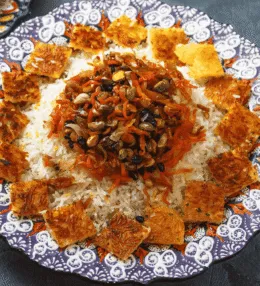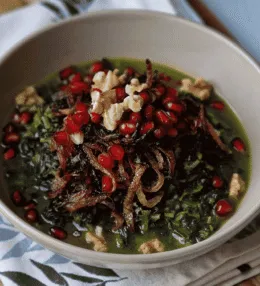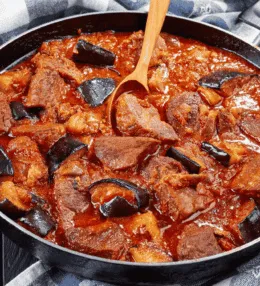
- View
Table of Contents
ToggleFarofa is a beloved side dish in Brazilian cuisine, known for its unique texture and flavour that brings a delightful crunch to many traditional meals.
Made from toasted cassava flour, Farofa is a staple that pairs beautifully with a wide range of dishes, from hearty feijoada (Brazilian black bean stew) to grilled meats and vegetables.
Its versatility and simple preparation make it a favourite across Brazil, adding both texture and a subtle, nutty flavour that complements any meal.
Want to dive deeper into Brazilian Cuisine? Don’t miss our post on 26 Traditional Brazilian Foods to Try
What Is Farofa?
Farofa is essentially toasted cassava flour, often cooked with a variety of seasonings and ingredients to enhance its flavour. Cassava, also known as yucca or manioc, is a root vegetable that plays a significant role in Brazilian cooking.
The flour is toasted in butter or oil until golden, giving it a slightly crispy texture that contrasts beautifully with softer dishes. Farofa can be as simple as plain toasted cassava flour or enriched with onions, garlic, bacon, eggs, and even dried fruits, depending on the region and occasion.
In Brazil, Farofa is served alongside a wide range of dishes, from barbecued meats at churrascos to classic feijoada, where it’s used to soak up the savoury juices and add a satisfying crunch to every bite.
The dish is beloved for its versatility, able to transform from a humble accompaniment to a rich, flavourful side dish depending on what’s added to it.
Ingredients and Taste
The main ingredient in Farofa is cassava flour, a finely ground flour made from the starchy cassava root. The flour itself has a neutral taste, but when toasted, it takes on a slightly nutty flavour with a delicate crunch.
The basic version of Farofa is toasted in butter or oil, often with onions and garlic for added flavour. From there, it can be customized with other ingredients like crispy bacon, chopped boiled eggs, or even sweet elements like raisins, creating a unique balance of savoury and sweet.
The flavour of Farofa is subtle yet rich, with the toasted cassava flour providing a slightly earthy undertone that enhances rather than overpowers. Its crumbly texture is what truly sets it apart, adding a delightful contrast to softer dishes.
When served with something like feijoada, Farofa absorbs the rich, savoury flavours while maintaining its own character, making it an indispensable part of the meal.
A Taste of History
Farofa has deep roots in Brazilian culinary history, tracing back to the indigenous peoples of Brazil who cultivated cassava as a staple crop. Cassava flour was a vital food source, and toasting the flour was a simple yet effective way to prepare it for meals.
Over time, Farofa evolved into a more elaborate dish, influenced by the diverse culinary traditions of Brazil, including African, European, and indigenous practices.
Farofa’s role in Brazilian culture extends beyond just being a side dish. It’s a symbol of adaptability and resourcefulness, a reflection of how simple ingredients can be transformed into something flavourful and essential.
It became especially popular at large gatherings and celebrations, where it’s often served alongside feasts of grilled meats, beans, and rice. Today, Farofa remains a beloved part of everyday meals and special occasions alike, treasured for both its flavour and its connection to Brazilian heritage.

Brazilian Farofa (Toasted Cassava Flour)
Ingredients
- 2 cups cassava flour farinha de mandioca
- 4 tbsp unsalted butter or olive oil
- 1 small onion finely chopped
- 2 cloves garlic minced
- 1/2 cup diced bacon or sausage optional
- 1/4 cup chopped parsley
- Salt and pepper to taste
Instructions
- To begin, preheat a large skillet over medium heat. This allows for even heating, ensuring the ingredients will cook without burning. Have your cassava flour measured and ready, as you will need it later in the process.
- In the skillet, melt 2 tablespoons of butter (or heat olive oil) and sauté the diced bacon or sausage (if using) for about 4-5 minutes until crisp. Remove the bacon from the pan and set aside, but keep the rendered fat in the skillet, as it will add flavour to the farofa.
- Add the remaining butter to the skillet, followed by the chopped onion. Sauté the onion for about 3-4 minutes until softened and golden. Stir frequently to avoid browning too much. Add the minced garlic, and cook for another minute until fragrant.
- Lower the heat to medium-low. Add the cassava flour to the skillet with the onion and garlic mixture. Stir constantly to toast the flour evenly, ensuring it absorbs the flavors and becomes golden brown. This process should take around 6-8 minutes. Keep an eye on it to prevent burning, as cassava flour can toast quickly.
- Season the farofa with salt and pepper to taste. Be mindful if you've used bacon or sausage, as they may already add saltiness to the dish. Adjust the seasoning accordingly for balance.
- Once the cassava flour is evenly toasted, return the cooked bacon or sausage to the skillet. Stir well to combine, allowing the savoury flavors to blend with the toasted flour.
- Remove the skillet from heat, and mix in the chopped parsley. The parsley adds a fresh touch to balance the rich flavors of the butter and bacon.
- Serve the farofa warm alongside grilled meats, feijoada (Brazilian black bean stew), or other main dishes. For an enhanced presentation, garnish with a sprinkle of extra parsley and a squeeze of lime if desired.
Nutrition
You May Also Like






